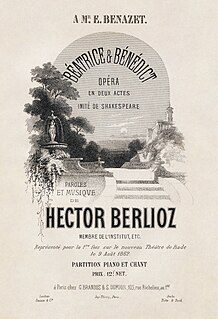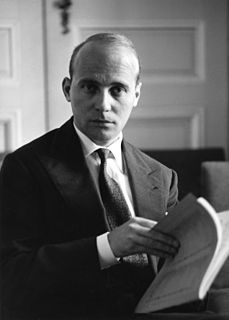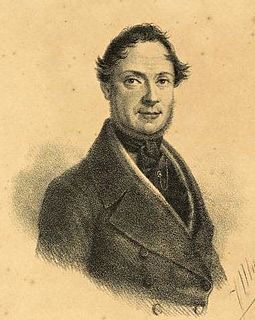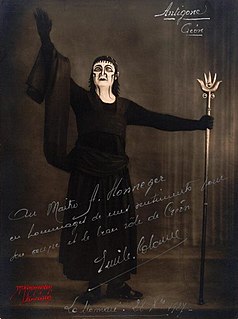Related Research Articles

Béatrice et Bénédict is an opéra comique in two acts by French composer Hector Berlioz. Berlioz wrote the French libretto himself, based in general outline on a subplot in Shakespeare's Much Ado About Nothing.

The Semperoper is the opera house of the Sächsische Staatsoper Dresden and the concert hall of the Staatskapelle Dresden. It is also home to the Semperoper Ballett. The building is located on the Theaterplatz near the Elbe River in the historic centre of Dresden, Germany.
Penthesilea is a one-act opera by Othmar Schoeck, to a German-language libretto by the composer, after the work of the same name by Heinrich von Kleist. It was first performed at the Staatsoper in Dresden on 8 January 1927.

Heinrich Sutermeister was a Swiss composer, most famous for his opera Romeo und Julia.

Fervaal, Op. 40, is an opera in three acts with a prologue by the French composer Vincent d'Indy. The composer wrote his own libretto, based in part on the lyric poem Axel by the Swedish author Esaias Tegnér. D'Indy worked on the opera during the years 1889 to 1895, and the score was published in 1895.

Der junge Lord is an opera in two acts by Hans Werner Henze to a German libretto by Ingeborg Bachmann, after Wilhelm Hauff's 1827 fairy tale "Der Affe als Mensch" from Der Scheik von Alessandria und seine Sklaven.

A Village Romeo and Juliet is an opera by Frederick Delius, the fourth of his six operas. The composer himself, with his wife Jelka, wrote the English-language libretto based on the short story "Romeo und Julia auf dem Dorfe" by the Swiss author Gottfried Keller. The first performance was at the Komische Oper Berlin on 21 February 1907, as Romeo und Julia auf dem Dorfe. Thomas Beecham conducted the British premiere at the Royal Opera House, Covent Garden in London on 22 February 1910. The US premiere was on 26 April 1972 in Washington, D.C.
Il prigioniero is an opera in a prologue and one act, with music and libretto by Luigi Dallapiccola. The opera was first broadcast by the Italian radio station RAI on 1 December 1949. The work is based on the short story La torture par l'espérance from the collection Nouveaux contes cruels by the French writer Auguste Villiers de l'Isle-Adam and from La Légende d'Ulenspiegel et de Lamme Goedzak by Charles De Coster. Some of the musical material is based on Dallapiccola's earlier choral work on a similar theme, Canti di prigionia (1938). Dallapiccola composed Il prigioniero in the period of 1944–1948. The work contains seven parts and lasts about 50 minutes. The musical idiom is serialism, and it is one of the first completed operas using that compositional method.

Lear is an opera in two parts with music by the German composer Aribert Reimann, and a libretto by Claus H. Henneberg, based on Shakespeare's tragedy King Lear.
Romeo and Juliet is a tragedy by William Shakespeare.

Falstaff, ossia Le tre burle is a dramma giocoso in two acts by Antonio Salieri, set to a libretto by Carlo Prospero Defranceschi after William Shakespeare's The Merry Wives of Windsor.
Der Widerspänstigen Zähmung is a German-language comic opera in four acts by the German composer Hermann Goetz. It was written between 1868 and 1872 and first performed at the National Theatre Mannheim on 11 October 1874 under the conductor Ernst Frank. The libretto, by Joseph Victor Widmann and the composer, is based on Shakespeare's The Taming of the Shrew. The style of the opera shows Goetz turning away from the musical ideas of Richard Wagner towards the classicism of Mozart. Der Widerspänstigen Zähmung was a huge success, not only in Germany but in the United States and in Great Britain, where it received high praise from George Bernard Shaw.

Romeo und Julie is a singspiel in three acts by composer Georg Benda. The opera has a German libretto by Friedrich Wilhelm Gotter that is based upon Christian Felix Weiße's translation of Shakespeare's Romeo and Juliet.

Giulietta e Romeo is an opera in two acts by the Italian composer Nicola Vaccai. The libretto, by Felice Romani, is based on the tragedy of the same name by Luigi Scevola and, ultimately, on the 1530 novella of the same name by Luigi Da Porto. It was first performed at the Teatro alla Canobbiana, Milan, on 31 October 1825. It was Vaccai's last major success, although he wrote another nine operas, and is rarely performed in its full version today.

Fennimore und Gerda is a German-language opera with four interludes, by the English composer Frederick Delius. It is usually performed and recorded in English, as Fennimore and Gerda in a translation by Philip Heseltine. The German libretto, by the composer himself, is based on the novel Niels Lyhne by the Danish writer Jens Peter Jacobsen. In neither German nor English is the libretto highly regarded; rather, the work is considered an "orchestral opera", limited in its dramatic appeal but voluptuous and engaging in its instrumental texture.

Antigone is an opera in three acts by Arthur Honegger to a French libretto by Jean Cocteau based on the tragedy Antigone by Sophocles. Honegger composed the opera between 1924 and 1927. It premiered on 28 December 1927 at the Théâtre Royal de la Monnaie with sets designed by Pablo Picasso and costumes by Coco Chanel.

Aldo Bertocci was an Italian operatic tenor who sang both comprimario and leading roles in a career spanning the late 1940s to the mid-1970s. He sang in the world premieres of nine 20th century operas, most of them in performances broadcast on the RAI, Italy's national public-service radio. His discography includes live recordings of several rarities such as Mascagni's Silvano and Leoncavallo's Zingari. Bertocci was born in Turin and from 1974 lived in Cassano Valcuvia where he died shortly before his 88th birthday.

Maria Carbone was an Italian operatic soprano. She created the lead female roles in two of Gian Francesco Malipiero's operas: the title role in Ecuba and Cleopatra in Antonio e Cleopatra.

Aladdin, Op. 43, is an opera by the Swedish composer Kurt Atterberg, to a libretto written by Bruno Hardt-Warden and Ignaz Michael Welleminsky. Two versions exist, in Swedish and German. The opera is based on the story, "Aladdin's Magic Lamp" from One Thousand and One Nights. It was first performed on 18 March 1941 at the Royal Swedish Opera, Stockholm.